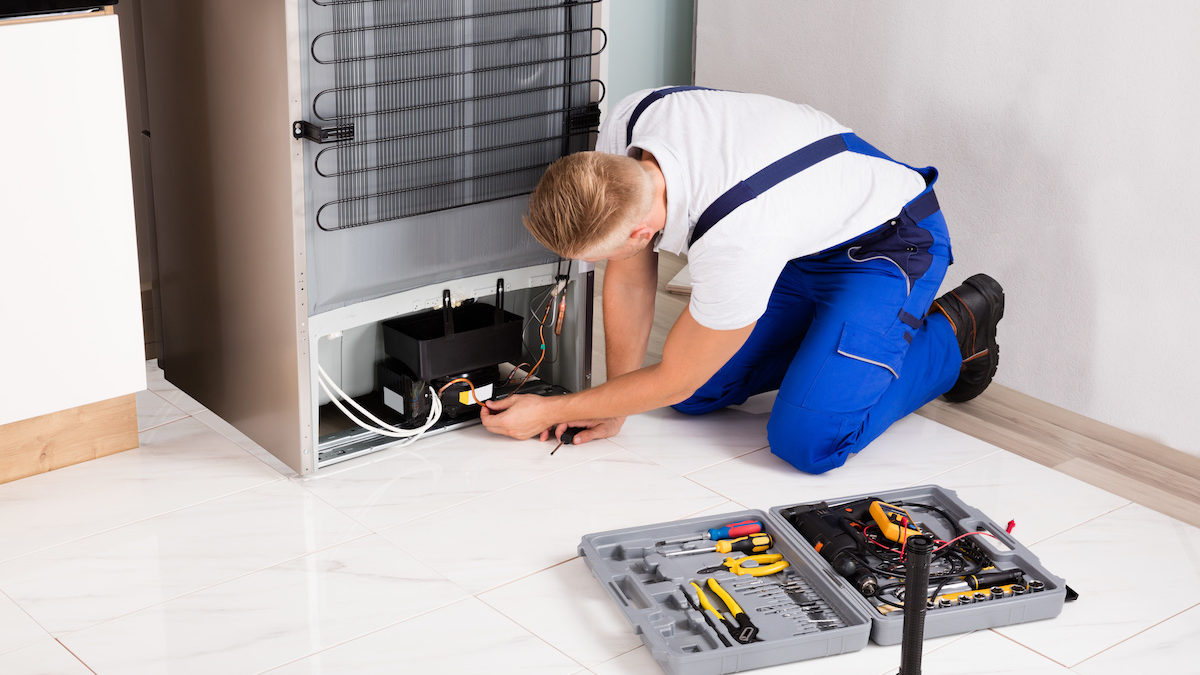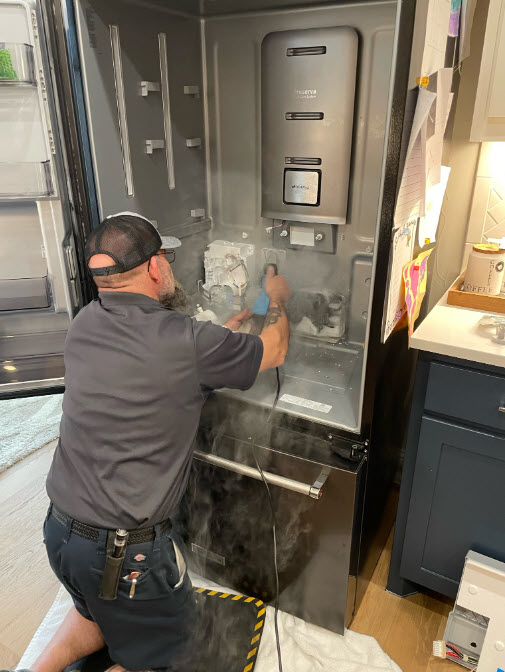True Story: Lower Bills and Less Stress with Dependable Appliance For SubZero Freezer Repair
True Story: Lower Bills and Less Stress with Dependable Appliance For SubZero Freezer Repair
Blog Article
The Ultimate Overview to DIY Home Appliance Repair Strategies
From fridges to dishwashing machines, understanding exactly how to fix and repair these devices can save you time and money. Are you all set to uncover important techniques that will empower you to handle repairs confidently?
Comprehending Typical Appliance Problems
When you count on your home devices, it can be annoying when they all of a sudden stop functioning or act up. Comprehending common device issues can help you troubleshoot issues properly.
If your stove isn't heating, damaged aspects or thermostat problems might be responsible. Dishwashing machines often experience issues with drain, so ensure the filter is tidy and the drainpipe tube isn't kinked.
Additionally, pay attention for uncommon noises; they often show mechanical issues. By identifying these signs, you can conserve time and possibly prevent expensive repairs. A little understanding goes a lengthy way in keeping your devices, so stay informed to maintain everything running smoothly.
Crucial Tools for DIY Fixes
Prior to diving into do it yourself appliance repair services, it is very important to gather the right tools to ensure the procedure goes efficiently. Start with a good set of screwdrivers, including both flathead and Phillips, as they're crucial for opening most devices. You'll likewise desire a pair of pliers for grasping and turning cords or tiny components.
Don't forget a multimeter; it helps you test electrical elements and identify problems properly. An outlet set is helpful for loosening up or tightening up screws, while an utility knife can be helpful for opening or reducing wires product packaging.
Finally, consider having a flashlight handy to brighten dark spaces inside your devices. With these vital tools, you'll be fully equipped to deal with numerous repairs, conserving both money and time. So, collect your gear and prepare yourself to roll up your sleeves!
Security First: Safety Measures to Take
Before you start any kind of device fixing, it's important to prioritize safety. Make sure you wear personal protective equipment, separate the source of power, and maintain your workspace organized. These easy precautions can help protect against crashes and assure a smoother fixing procedure.

Individual Protective Tools
Security gear is a vital part of any type of DIY appliance repair service job. Steel-toed boots are also a wise choice, specifically when raising heavy devices. Keep in mind, being prepared with the best gear maintains you secure and focused on finishing your fixing effectively.
Source Of Power Disconnection
To guarantee a risk-free Do it yourself appliance repair, separating the power resource is important. This straightforward action protects against electric shocks and guarantees that you can concentrate on the repair without stressing concerning accidental activation. When you're confident that the power is separated, you can confidently proceed with your repairs, understanding you've taken the needed preventative measures to protect yourself.
Workplace Organization
An efficient workspace can make all the difference in your do it yourself home appliance repair task. Begin by removing your work space of clutter to avoid accidents and diversions. Lay out all your devices and products, grouping comparable items with each other for simple access. Utilize a tool kit or coordinator to maintain small components like washing machines and screws consisted of and classified. See to it you have actually got sufficient illumination; it'll aid you see information plainly and minimize the threat of mistakes. Do not neglect to keep safety and security gear like gloves and goggles within reach. Finally, have a trash bag handy to throw away waste promptly. A clean space not just increases performance but also maintains you secure while you work with your home appliance repair service.
Step-by-Step Overview for Refrigerator Repair Works
When your refrigerator starts breaking down, it can be aggravating, but dealing with the problem on your own can conserve you money and time. Initially, unplug the fridge to guarantee safety and security. Look for common concerns like temperature level fluctuations or unusual noises. If it's not cooling down, examine the thermostat settings; they might be set as well high. Next off, clean the condenser coils, which typically accumulate dust and debris. For a loud refrigerator, examine the follower and verify it's not obstructed.
If there's water pooling inside, examine the door seals for damages or dust, and tidy them if required. For ice buildup, clear the defrost drainpipe. Plug the refrigerator back in and check it for a few hours as soon as you have actually addressed the issue. If the problem persists, you might require to change a malfunctioning part, like the compressor or fan electric motor. Bear in mind, do not think twice to seek advice from the manual or look for specialist aid if needed.
Repairing Cleaning Device Concerns
Simply like refrigerators, washing equipments can provide their own collection of challenges, but lots of concerns can be fixed with a bit of troubleshooting. If your equipment won't start, inspect the power cord and validate it's connected in.
Tightening up these can usually resolve the trouble. Normal maintenance, like cleaning the filter, can protect against several issues from arising.
Repairing Ovens and stoves
Exactly how can you fix common problems with your oven or cooktop? Beginning by examining the power supply. Ensure it's plugged in and the circuit breaker is not stumbled. Validate the gas valve is open if it's a gas range. Next, test the heaters: if they do not spark, cleanse the igniter and look for obstructions in the heater ports.
If your stove isn't home heating, check the temperature settings and confirm the door seals tightly. If it's damaged., a malfunctioning heating element can also be the culprit; you could need to replace it.
For uneven cooking, rotate your pans and think about making use of an oven thermostat to verify accurate temperature levels. If you hear uncommon noises or odor gas, turn off the device immediately and get in touch with a professional. By adhering to these actions, you can determine and resolve many typical oven and range concerns efficiently.
Fixing Dishwashers Made Easy
When your dish washer begins acting up, it can be irritating, however attending to typical problems isn't as difficult as it appears. You'll find out detailed troubleshooting techniques that will help you identify the problem, in addition to the important devices you'll need to take on fixings yourself. Allow's make repairing your dish washer a wind!
Typical Dishwashing Machine Problems
While dishwashing machines are made to make your life simpler, they can occasionally run right into common problems that leave you really feeling irritated. If your dish washer's door won't latch, it can be an easy concern with the latch system or door seal. Resolving these issues early can save you time and headache down more information the road.

Step-by-Step Troubleshooting
Before diving right into repairs, it's vital to identify the specific concern your dish washer is encountering. If your dishwashing machine won't start, check the power supply and door lock. By systematically attending to each prospective issue, you can pinpoint the problem and take the necessary actions to repair it, making your dishwashing machine function like new once more.
Essential Repair Devices
Having the right tools at your disposal can make all the difference when repairing your dishwasher. Do not neglect a container or towels for any water splashes during repair services.
You may also desire a level to ensure your dishwashing machine's properly lined up. With these necessary tools, you'll be fully equipped to deal with any dishwasher fixing obstacle that comes your way.
Often Asked Concerns
Just how Do I Establish if an Appliance Is Well Worth Fixing?
To figure out if a home appliance's worth fixing, consider its age, repair prices, and current worth. If fixings surpass half the replacement cost, you could wish to purchase a new model instead.
Can I Discover Substitute Components In Your Area for My Home Appliance?
Yes, you can typically discover substitute parts in your area for your device. Check equipment stores, device service center, or neighborhood classifieds. Don't fail to remember to bring the model number to assure you get the proper part!
When Fixing Appliances?, what Common Mistakes Should I Stay Clear Of.
When fixing home appliances, stay clear of rushing through diagnostics, neglecting safety preventative measures, or utilizing wrong tools. Do not avoid checking out handbooks or viewing tutorials; they supply crucial support. Hold your horses and complete to guarantee effective fixings and protect against additional damage.
The length of time Does a Typical DIY Home Appliance Repair Take?
A common DIY vacuum cleaner repair shops near me appliance fixing usually takes one to three hours, depending on the complexity. You'll intend to collect your tools and materials initially, and follow guidelines carefully to stay clear of unneeded hold-ups.
Are There Any Type Of Warranties for DIY Appliance Services?
When you deal with do it yourself device repair work, service warranties normally do not cover your work. However, some makers may recognize warranties for components you change. Always inspect your home appliance's guarantee terms prior to starting any repair work to avoid problems.
Before diving right into DIY device repair work, it's vital to collect the right devices to assure the process goes smoothly.Prior to you start any kind of appliance repair work, it's crucial to prioritize safety.To ensure a safe Do it yourself appliance repair, detaching the power source is important.An efficient work area can make all the difference in your Do it yourself appliance repair service project. click for more info Always inspect your device's guarantee terms before starting any repair services to avoid concerns.
Report this page